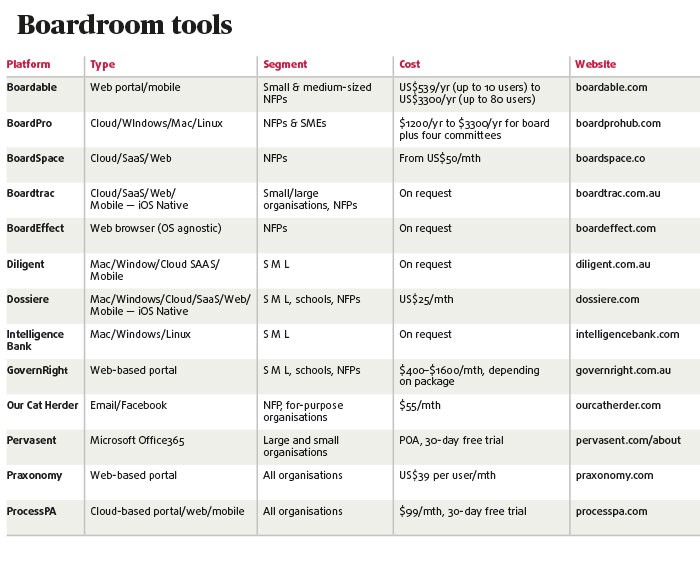From financial reporting to key performance indicators, board and management reporting is vital for all organisations. Here are some new reporting platforms to help lift your game.
Corporate board management and reporting is a vital element of board life, but can be a complicated, time-sensitive process with high stakes. Directors and company officers must have efficient, effective, compliant and secure systems to collate, report and manage information in order to support board decision-making. In the wake of the banking Royal Commission, minute-keeping and information overload have become key issues.
In her post-Royal Commission AICD web article, Board Reporting: Improving the quality without increasing the quantity, AICD facilitator, Dr Judith MacCormick FAICD, CEO of BoardFocus Advisory, wrote that companies and their boards can face serious consequences for omissions or oversights. “Board reporting is inevitably part ‘art’ and part ‘science’; a ‘tick-a-box’ approach is likely to hamper development of a culture that is both performance and accountability/ethically oriented,” she wrote.
For many organisations and NFPs, a complicating factor is that processes grow over time and they can end up with inefficiencies and security risks associated with collating and sharing board materials through board packs on email.
There was much discussion on the issue at the AICD’s Essential Director Update (EDU) in Sydney in October, where the Australian Securities and Investments Commission (ASIC) launched its report on director and officer oversight of non-financial risk.
On its findings, ASIC noted: “Material information about non-financial risk was often buried in dense, voluminous board packs. It was difficult to identify key non-financial risk issues in information presented to the board. Boards should require reporting from management that has a clear hierarchy and prioritisation of non-financial risks.”
ASIC chair James Shipton said: “Board packs were so dense and voluminous it was unclear whether their primary purpose was to inform directors in the most effective manner or to avoid the authors having to make a call on what material to exclude or provide in a hierarchy of those risks.
“The average pack provided to the board risk committees in the companies we studied was 300 pages long. Many directors acknowledged the problem of being overwhelmed with information before a board meeting.” He said the ASIC review found precisely the opposite applying at the other end of the meeting process — with board minutes drafted sparsely and failing to evidence a sufficient level of engagement or involvement by directors outside of detailing the actual decision.
Graham Bradley AM FAICD, chair of Graincorp and HSBC Australia, said good board minutes were assisted by good board papers clearly articulating resolutions proposed by management and the considerations that supported the outcome.
Urbis chair Lisa Chung FAICD added that a lot of work was required to produce quality board reports and to educate the authors of these reports to ensure they were of maximum use to the board.
Filling the gaps
“Directors are expected to dig deeper, bring diverse perspectives to the board table and they need better analytical tools to ensure they’re not missing an important part of the overall picture,” says Brian Stafford, president and CEO of governance technology provider Diligent Corporation.
These days, better tools are available to cater to the board’s and management’s needs. “There are more board portal or reporting tools in the market than one can list,” says Raphael Goldsworthy, managing director of Better Boards, which owns the board meeting organiser Our Cat Herder.
Brett Herkt, the co-founder and CEO of New Zealand software company BoardPro, breaks the market into two parts. He says the first consists of corporate portals. These have been around for about 15 years and are used by larger companies. The costs of using them can range from $5000 to $20,000 per year, depending on the number of users and board committees using a portal.
While there are at least 50 different offerings from all over the world, Herkt says Diligent is the clear leader globally and in Australia and NZ. Diligent claims it is used by “63 per cent of the ASX 100”.
“Corporate board portals tend to be a document repository and security tool for bigger boards,” says Herkt. “They predominantly serve directors and offer very deep security features and deep document management services. They help workflow and have voting and communications tools.”

SME focus
Herkt adds that the second part of the market consists of a newer category of board management software aimed at small to medium-sized businesses and NFPs that can’t justify the expense of a corporate portal. “We are much more of a workflow tool,” he says. “Like internet banking, we layer in a set of tools.”
He says his company provides discounts for NFPs and Herkt estimates there are six to 10 organisations worldwide addressing this sub-$3000 a year market, although none has a major slice. “We are building more tools for administrators,” he says. “They can drag and drop board papers or build a board pack or distribute papers with a click of a button. We aim to automate and streamline the process — from setting an agenda to scheduling a meeting or setting action items in the minutes.”
Our Cat Herder also serves this end of the market, with both NFP and for-purpose organisations as clients. “We charge a subscription per legal entity, not per user,” says Goldsworthy. “Per-user pricing, particularly given how many people are often involved with the board, is benefiting the board portal provider, not the user.”
He notes there are few Australian companies in the board-portal space. “Only a handful are 100 per cent Australian-owned and operated. Several local companies have been recently sold to large international players and another has shut down.”
Australian company GovernRight was developed by Simon Neaverson FAICD, founder and managing partner of The Professional Partner Group and an AICD course facilitator. Neaverson says the technology is only about 10 per cent of the story; what counts is the alignment of the content to the governance obligations of the board to ensure it is focused on what it should be focused on.
“A board portal is as simple as a Dropbox,” he says. “It’s just software; content is different.”
He says the content of board papers should focus the board’s attention and discussion on its obligations — that is to:
- Oversee strategy implementation of the organisation.
- Oversee management of identified risks in business.
- Position the organisation for emerging items — the other side of change.
Neaverson says director obligations continue to evolve and governance solutions need to keep pace. The Queensland coronial inquiry into Ardent Leisure Dreamworld has begun a focus on how far directors need to enquire regarding positive assurances on the implementation of policy, rather than simply having a policy. “Just having a policy is so 2015, knowing it is being followed is 2020,” he says. “A good governance solution will allow positive assurance on adherence to critical policies from the field, supporting modern oversight of risk.”
He has concerns about some functions of the available technology on the market. “Some of them track which director saw which document at what time. The problem is that this could potentially be providing some evidence as to whether the board was acting reasonably by looking at content for a long enough period of time. It’s fairly uncontrolled as to what content goes to the board. A lot of information may go up for noting and then becomes rich text searchable and this could cause challenges. Finally, a concern is how these board portals treat annotations. They take annotations, which is good because directors can demonstrate they have considered the questions before the meeting. Some systems seek to remove the annotations after a specific time rather than having directors close off the annotations themselves.”
Goldsworthy cautions board technology is not a silver bullet. “We often get clients coming to us prematurely,” he says. “They think software will solve the myriad issues that the board has. The fact is, while board portal software can and does help boards in many ways, it should often be further down the list of priorities than boards think it should be. Boards need to ensure their board operations, administration and reporting are best practice — or close to — and then think about software. But software won’t fix board dynamics issues, which many boardroom issues stem from.”
Read our report on board papers and meeting effectiveness here.
Board reporting: Improving the quality without increasing the quantity
Banking Royal Commissioner Kenneth Hayne AC stated: “Boards cannot operate properly without having the right information from management.”
So, what is the “right” management information, and the “right” way to present it? Before you launch into aggregating an overwhelming array of data, take a strategic view of the task. Take your board request and a blank sheet of paper and write your responses to the “PACKO” headings.
P for PURPOSE Why should a director read this? For example, the purpose of this paper is to facilitate directors’ ability to contribute value to board decision-making.
A for AUDIENCE What is the knowledge base of the individual directors? As all directors are equally responsible for board outcomes, reports need to be understood by all, irrespective of backgrounds. For example, both reader/directors and writer/managers of board papers across all sectors should find these tips valuable.
C for CONTEXT What has happened to prompt this report, now? For example, Commissioner Hayne has underlined the imperative for directors to get the right information if they are to undertake their roles effectively and avoid personal liability.
K for KEY MESSAGES What are the three takeaways you want your directors to remember?
O for OUTCOME What do you want directors to do as a result of reading this paper?
Avoid reporting creep
Senior management is sometimes treated as though its time is limitless. Board decisions or requests for information receive high priority regardless of the managers’ capacity to drive them forward. Provision of this information adds to the already considerable resource required to compile papers and/or presentations for the board. Each request becomes another element to be routinely reported, all leading to reporting creep.
To optimise management’s time and ensure quality reporting, requests from the board should be calibrated against:
- What are the resource and capacity requirements to deliver on this request?
- Does this matter accord with the delegation of authority policy? Is it a board issue?
- How important and urgent is the issue, and what are its implication/relevance for the company?
- Is this a new issue, or can existing information or reports better respond to the request?
- What is the underlying question we are hoping to better understand? Is there better or different information we should be requesting?
And, in the interests of continuous improvement and reinforcing the collaborative endeavour of board reporting between directors and management, be sure at the end of every meeting to provide management with feedback on what was valued and what could be improved, added or deleted.
Taken from Effective Board Reporting by Dr Judith MacCormick FAICD, CEO Board Focus.
Latest news
Already a member?
Login to view this content


